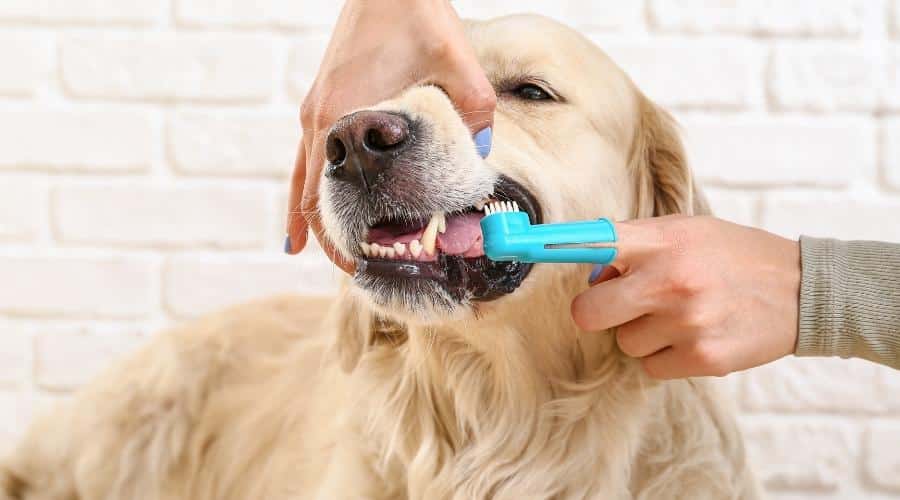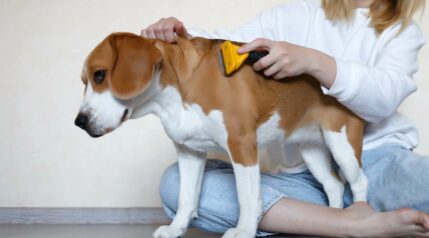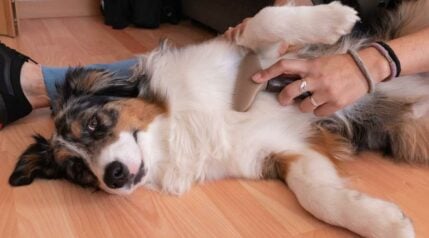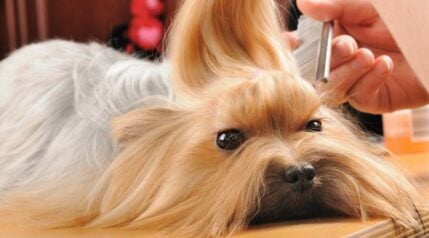Keeping our teeth clean by brushing and visiting the dentist regularly are vital parts of keeping our mouths healthy. But how do you make sure that your canine companion’s teeth and gums are just as healthy?
Brushing your dog’s teeth is proven to reduce bacteria build-up, which means they’re less likely to develop plaque and tartar, minimizing painful gingivitis, infections, and tooth loss. Brushing your dog’s teeth at least every other day ensures that they get the full benefit.
The truth is it’s unlikely that you’ll ever get your dog’s mouth as clean as your own unless they’re incredibly tolerant and you have a lot of time. However, that doesn’t mean that a good homecare routine won’t help keep your furry best friend’s mouth clean and comfortable.
At a Glance: Top Teeth Brushing Products

Best Dog Toothbrush
Vetoquinol Enzadent
Dual-Ended

Best Dental Finger Brush
Vet’s Best
Dental Finger

Best Dog
Toothpaste
petsmile
Note: Clicking the above links take you to Chewy.com, where you can get additional product information and customer reviews. If you make a purchase, we earn a commission at no additional cost to you.
What Is Dental Disease?

Dental periodontal disease comes into play when bacteria build up on your dog’s teeth surface and under the gumline. The gum and other soft tissue supporting the tooth become inflamed and infected, and the gum starts to recede over time. As the gum recedes, more and more of the tooth root is left exposed.
Periodontal disease is painful for your pooch and can lead to tooth loss and even life-threatening infection. Not only this, but bad teeth can also cause your pooch to have bad breath. So, if you’ve been trying to dodge kisses from your furry friend, or you’ve stopped enjoying cuddles with them, they could have bad teeth (or something worse).
Why Is Brushing Your Dog’s Teeth Important?
When you brush your dog’s teeth, it disrupts the biofilm of bacteria that coat each tooth. This biofilm eventually leads to the formation of plaque and tartar. So, brushing frequently prevents the onset of dental disease, meaning your pooch is not in pain and can hang on to their gnashers for as long as possible. Dog’s teeth don’t clean themselves (and they can’t do it) so it’s up to us as responsible pet parents to help prevent dental disease and plaque buildup on their teeth with a regular oral cleaning regimen.
When Should You Start Brushing Your Dog’s Teeth?
It’s never too early to start brushing your dog’s teeth. As long as they have teeth, you can give it a go. This means that from just six or eight weeks old, you can start the process of getting them used to the toothbrush and paste. Just be cautious when they are teething, or baby teeth start to fall out, as their gums are more tender and sensitive.
You might be thinking, “But don’t puppy teeth fall out at six months old after teething? What’s the point?” Well, yes, it’s true that if you start young, you’ll be cleaning their temporary teeth, but even though puppy teeth fall out, it’s still beneficial. After all, the sooner you get your brand-new pup familiar with their dental routine, the more likely they are to accept it without being fearful or intolerant for the long haul.
How Often Should You Brush?
As humans, we’re recommended to brush our teeth at least twice a day, but ideally after every meal. However, this would be a big commitment when it comes to looking after your furry family member. Although the more you do it, the more benefit they have, realistically, daily, or every other day is sufficient to impact your dog’s oral health. It’s best to try brushing at least every other day, though, because less often allows bacteria to build up in between brushing, and your efforts might be wasted.
What If You Can’t Brush Regularly?
If you follow the method and tips below, you’ll hopefully have some success getting your dog to accept having their teeth brushed. However, if your dog still doesn’t tolerate it, perhaps due to behavioral issues or pain, there are some alternatives you can try.
Feeding dry dog kibble rather than wet food is proven to help reduce dental disease. The texture doesn’t stick as easily, and the crunching can actually help remove some build-up. Additionally, some dog chews and dental diets are specially formulated to cause friction against the surface of the teeth, removing plaque.
Other products like antibacterial doggy mouthwash and gels that fight infection on the teeth are also helpful if you can’t brush. However, it’s worth spending some time learning doggy toothbrushing first because it’s the most effective method of keeping your dog’s mouth in tip-top condition.
What If Your Dog Has Bad Breath?
Despite thinking that a dog’s stinky breath is normal, it’s not. A smelly odor in their mouth could be a sign of dental disease that requires attention from your vet. Other signs of dental disease include red gums (healthy gums are pink), pus around the gums, facial swelling, yellow or brownish buildup, or signs of pain in the mouth.
How Do You Brush Your Dog’s Teeth?

Get Supplies
Luckily, there are many options for choosing the right tools for brushing your dog’s teeth. Some dogs might allow you to put your fingers in their mouth but are wary when you’re holding a toothbrush. In this case, you could try a finger brush, which fits on your finger like a thimble.
There are also many dog-safe toothpaste options, including this option that comes with a toothbrush that comes in yummy flavors like chicken or cheese, which they should enjoy. Never use human toothpaste on your dog. Flouride and other detergents can be harmful if swallowed. Hydrogen peroxide can be harsh on their gums and also bad if ingested. And avoid baking soda as it’s high in sodium.
Choose A Location
Choose your location wisely if you anticipate your mischievous mutt might be a bit of a wriggler. A quiet corner with no opportunities for quick escape is best. You might also want to choose somewhere with wipeable surfaces if you don’t want to clean up turkey toothpaste squashed into the carpet or curtains.
Ask For Help
Eventually, brushing your dog’s teeth might be a one-person job, but that’s not usually the case on day one. So, it’s worth asking a calm family member, friend, or neighbor to give you a hand. If someone can gently and safely restrain your canine companion, it’ll make it much easier for you to focus on the job at hand…or mouth as the case might be.
Use Positive Reinforcement
Brushing your dog’s teeth isn’t just a new experience for you. It’s also a new and potentially scary experience for them. It’s important not to punish them if they’re not immediately compliant but reward good behavior with a tasty treat and lots of rubs.
Start Slow
Make sure you have plenty of time available before you start because it’s best not to rush. On the first attempt, try getting your dog to lick some of the paste from your finger or the brush if they feel brave. Once they’re calm and relaxed, you can build up to brushing a single tooth. Over time, you should be able to do more until you can brush all of their teeth in one sitting.
You might also try getting them used to putting your fingers in their mouths first by using something other than toothpaste. Rub a piece of gauze or clean wash rag with chicken or tuna and wrap it around your ringer. Let them sniff your finger and touch their lips with it. Work up to rubbing their teeth with your fingers until they are comfortable.
Brush The Teeth
When you brush each tooth, use up and down motions, and try to make sure you cover the entire surface of the tooth, rather than just the side that’s facing you. Although the front side is more important. It’s also worth focusing on the gumline itself. However, you should take care because this area might be tender if your dog has gingivitis.
Don’t Push Your Luck
You should never ignore signals from your dog. If they are turning their head away, trying to get away, or even growling or trying to bite, they’re communicating that they’ve had enough. Continuing to brush their teeth despite them being uncomfortable does more harm than good in the long run. You might even make them less tolerant on your next attempt. So, as soon as you see signs that your dog wants you to stop, you should give them a break. You can always come back tomorrow and try again.
Make It Routine
Once you’ve started, it’s a good idea to make toothbrushing a regular part of your dog’s routine. Each time you do it, they should become more relaxed and comfortable. Eventually, they might enjoy bonding time and showing off their pearly whites. Evening when they are relaxed and calm, or before meal time, rewarding them with food afterward.
Frequently Asked Questions

What can I use to brush my dog’s teeth?
Dog toothbrushes come in many forms, from finger brushes to long plastic toothbrushes. Which particular brush suits your pooch’s pearly whites depends on their temperament and the shape of their mouth. And remember, there’s nothing wrong with using an appropriately-sized human toothbrush, but you should never use human toothpaste, as fluoride is toxic to dogs. Choose a pet-safe toothpaste, available in several different meaty flavors, to help your dog enjoy dental hygiene time.
What is the easiest way to brush a dog’s teeth?
A slow and gentle approach with treats for positive reinforcement helps to ensure you have the most success. Follow the steps in this article for some extra ideas. We have also heard that some pet parents have more success first thing in the morning or before bed when dogs are already in relaxation mode.
What should you do if your dog won’t let you brush its teeth?
If your dog doesn’t let you brush their teeth, you can try other ways to keep their mouth healthy. Feeding dry dog food is one of the most significant ways to improve your dog’s dental health. Dental diets and chews, doggy mouthwashes, and antibacterial gels can also be helpful.
Final Thoughts
It’s not just important for people to brush their teeth. It’s also important for them to brush their dog’s teeth. It might seem like a chore, but brushing your dog’s teeth has a hugely beneficial effect on their oral health and prevents painful gingivitis, serious infections, and teeth loss.





